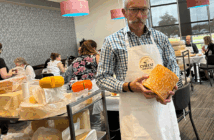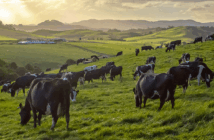Climate change necessitates a transition to clean energy and the best locations for solar energy projects are on flat land, close to roads and infrastructure. This often means using valuable agricultural land, but as we head towards 10 billion people by 2050 we need all the agricultural land we can get. Add to that the fact that farmers often do it tough and we have a major problem. So how about a technology that improves yields, protects crops from the weather, and brings farmers an additional income? Enter Agrivoltaics, it’s all about planting crops under solar panels.
Installing solar panels above plants has many benefits. Researchers have found that crops like coriander, peppers and tomatoes grow just as well under solar panels as in the open and can use up to 50% less water. The panels also shade the plants from the extreme heat associated with climate change, preventing yield loss. In fact, different solar panel transparencies can be used for different crops. They also protect crops from heavy rainfall. The panels can even be made tiltable to allow access for large farm machinery. Animals can graze below, and they also appreciate the shade on a hot day.
Even some governments are starting to realise the benefits of agrivoltaics with the Italian government allocating €1.1 billion to the technology in April 2021.
Some examples are;
- Jack’s Solar Garden in Boulder County Colorado is growing crops including carrots, kale, tomatoes, garlic, beets, radishes, lettuce, under solar panels. All while generating enough electricity to power 300 homes.
- Focola’s greenhouses in New Caledonia cover 22,000 square metres of land and can produce some 200 metric tonnes of vegetables per year while generating 2 GWh of power per year.
The icing on the cake is that water evaporating from the soil and given off by plants cools the overhead panels, increasing their efficiency.
Using less water and maximising the efficient usage of arable land are key to feeding the growing population. They’ll need more energy as well so this solution could indeed be a perfect marriage of food and technology.
Tony Hunter is a global futurist, food scientist, speaker, and foresight strategy consultant. He consults and speaks globally, using his distinctive combination of scientific qualifications, business experience, and detailed understanding of exponential food technologies to deliver a unique perspective on the future of food.





























































































